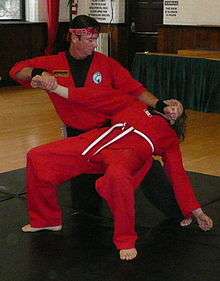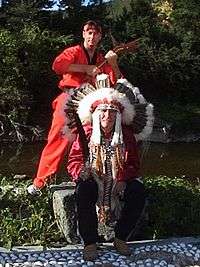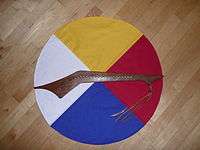Okichitaw
 Okimakhan Lépine demonstrating a technique | |
| Focus | Eclectic |
|---|---|
| Country of origin |
|
| Parenthood | Traditional Cree fighting techniques, judo, taekwondo, hapkido |
| Olympic sport | no |
Okichitaw is a martial art based on the fighting techniques of the Plains Cree First Nations.[1] It was founded and developed by Canadian martial artist, George J. Lépine.[2]
History
Origins
In his youth, founder George J. Lépine learned traditional wrestling, tomahawk throwing and hand-to-hand combat techniques (miche che kiske). He also trained in judo, taekwondo and hapkido. Lépine developed Okichitaw and established it in 1997. It is based in Toronto, Ontario. Lépine is the Director and Chief Instructor ("Okimikahn Kiskino Huma Kew" in Cree). George Lépine is Plains-Cree Michif from Manitoba and learned traditional hunting and tracking practices from a very young age. Teachings of traditional fighting techniques were also passed onto him. He started martial arts at age thirteen in Winnipeg. As he was progressing in his martial arts training, his Taekwondo Grandmaster encouraged him to embrace his traditions of native combat and to find ways to preserve, research and perpetuate this knowledge. This direction and guidance was also pressed into him by Traditional Elders throughout the Aboriginal Community. on Canadian Plains Cree combat principles and methods – both from his own teachings and through extensive historical research – Okimikahn Lépine combined this knowledge of native combat with his aboriginal culture and values and his extensive martial arts experience to create Okichitaw. For 20+ years he has been distilling this knowledge, codifying and systematizing it into a modern martial arts system. Okichitaw is a renewed expression of this traditional warrior knowledge, carrying these techniques and tactics and values to the present and into the future.
His family's aboriginal ancestry and contributions are well documented throughout the provinces of Manitoba and Saskatchewan. George’s Grandfather – Ambroise Lepine – was Louis Riel’s Adjutant-General for the Métis Provisional Government during their struggles in the late 1870s and 1880s. The political strategies adopted by the Métis Government had roots stemming from the politics of the buffalo hunt, which was overseen by Ambroise Lepine. In charge of the military action, Ambroise facilitated every movement of the Métis. Since Ambroise worked together extensively with Riel, the Métis Government cast Ambroise as a major player in the Métis Government.
Okimikahn Lépine has served as President for the Toronto Métis Council, Regional Councillor for the Métis Nation of Ontario, National Delegate for the Aboriginal Languages Initiative, President for the Native Canadian Centre of Toronto, Executive for the Ontario Aboriginal Sports Circle, and the Vice President for the North American Indigenous Games International Council. He is very active in all aspects of the Aboriginal Community throughout Canada, educating people through his experiences and culture.
In the early 1990s, Lépine began to organize and codify these techniques and methods, resulting in the system as it is practised today. The main Okichitaw training lodge (mistiko kamik) is located at the martial arts school of the Native Canadian Centre of Toronto and the art is disseminated through classes, workshops and demonstrations.
The scarcity of original reference materials casts doubt upon any attempt to reconstruct indigenous systems; since the latter half of the 20th century, there has been an emerging acceptance of oral traditions as sources of historical record.[3]
Elder Vern Harper has been involved with Okichitaw from its early stages, advising and encouraging Lépine in its development. Harper officiates at Okichitaw ceremonies and promotions tests.

Recognition
Lépine presented Okichitaw at the Chungju World Martial Arts Festival in 2002 where it was formally recognized as a unique indigenous martial art of Canada by the World Martial Arts Union.[4] The Chungju Festival, the largest festival of its kind, is an annual forum and showcase for indigenous martial arts, with the country of each art's origin fielding teams. For example, only Japanese teams may demonstrate Karate, and only the Canadian team may present Okichitaw. In 2004 and 2008, Lépine led Okichitaw demonstration teams representing Canada at the Festival.[4]
World Martial Arts Union (WoMAU)
The World Martial Arts Union carries out the work with the aim of exchange and cooperation between martial arts organizations, promotion and conservation of each country's traditional martial arts, research and study of martial arts and contributes positively to world peace.
World Martial Arts Union (WoMAU) was first established in 2002 by representatives from 28 countries and agreed that the origin of traditional martial arts should be conserved, disseminated and developed at an international level and there should be an international organization for exchanges between nations undertakes organizing study and research activities such as seminars and conferences relating to martial arts, organizing or sponsoring demonstration or exhibition events, and providing administrative and technical assistances to the member organizations with a view to facilitating their participation in events.
With this, WoMAU which has been building massive archive with a view to systematically collecting, exchanging and disseminating traditional martial arts data through exchanges of personnel and information between the member organizations tries to establish a firm foothold for world central organization in the field of martial arts based on an official relation with UNESCO.
Training
Offensive
Weapons are introduced early in a student's training because of the influence of the weapons on the hand-to-hand techniques. The main weapons used in the Okichitaw martial arts system are the Gunstock Warclub and the Long Knife. Although only advanced students will train with these weapons, all hand techniques of Okichitaw are based on the hand positioning and attack applications of these specific weapons.

The primary weapon of Okichitaw is the gunstock war club, (nontoni towin mistik). These war clubs were originally a derivative of the flint musket rifle stocks, although later versions were made to simulate the rifle stock shape and The Plains gunstock war club has a characteristic elbow in the stock in both the long (horseback) or short (ground) versions.
Tomahawk, short and long lance and Plains dagger are also part of basic Okichitaw training.[4] Hand-to-hand techniques often assume the use of tomahawk and knife, but do not always rely upon the use of weapons. In Okichitaw, the hand positions are held as though there are weapons – in the same way that Aikido's kamae position assumes the use of a sword – but, as in Aikido, the techniques do not presuppose use of weapons. Most Okichitaw techniques have both weapon and open-handed variations but the focus is primarily through the application of hard forearm impact techniques.
Defensive
As in many martial arts, much of training is based upon one-to-one combat. The attacker initiates the combat, offering a physical threat using basic weapons – tomahawk and knife attacks, or a punch. The student demonstrating the technique responds to the attack, usually by immediately moving into the attacker's space with a combination of blocks, strikes, holds, rolls or throws to complete the technique.
As in other grappling arts, rolls, flips and body dives are means of extricating oneself from an attack. In Okichitaw, these maneuvers are also methods of moving into a technique - the flip, roll or body dive are part of the takedown.
Etymology
The word Okichitaw is based on the Plains Cree okichitawak, an honorific applied to Cree warriors by the Elders after a younger man had proved himself in battle. Okichitawak was used to describe the warriors within the community who had developed special skills used for survival, protection and warfare. The name Okichitaw was suggested by Elders in Lépine's native Manitoba when he sought guidance in naming the martial art. Okichitawak was modified to be easily pronounced by non-Cree speakers.
Philosophy
Ceremonies and promotional testing of Okichitaw is based on Cree warrior society of the Canadian plains. Modern-day training is intended to give the Okichitaw student direction and focus through self-challenge and confronting his or her fears and limitations in a controlled environment while building physical and mental strength. Warriors in Cree societies are called 'People who watch over people': that concept of peaceful, protective engagement is central to the philosophy and practice of Okichitaw.
'Grandfather teachings'
Love, Respect, Humility, Honesty, Wisdom, Bravery and Truth are the seven Grandfather teachings that inform the training and application of Okichitaw. Every student is expected to adhere to these basic principles in all aspects of their training. Proper conduct is required from students in their daily lives and interactions; this includes a renunciation of unnecessary violence and a commitment to conflict resolution in their lives.
Medicine Wheel and Four Directions
Among the indigenous peoples of North America, there is great significance to each of the Four Directions.[5]
In daily training, the Four Directions are used when challenging an attack: a response is devised within a fraction of a second (east) and techniques are employed with energy, movement and commitment (south), so that the adversary is effectively controlled by the technique (north), before finally being taken down (west). All techniques are executed in an environment of the highest respect and restraint.
East: The east represents balance, confidence and creativity. In battle, the East influences the identification or location of an adversary, and when setting up and developing a solid attack position.
South: The south represents strength, focus and success. In battle, the South influences the brave, aggressive challenge of an opponent.
North: The north represents courage, energy and knowledge. In battle the North influences the control of an opponent with surprise or overwhelming force.
West: The west represents challenge, choice, and proof. In battle, the West influences the takedown and finishing off of an opponent before moving on the next adversary.
The teachings of the “Old Ones” also refer to the Seven Grandfather Teachings which embraces good manners, courtesy, respect and consideration for others. Ethics, on the other hand, is a fundamental set of acceptable behaviors which codifies the spirit of the martial arts and which martial artists can rely on to develop their mind and body, and to guide their everyday actions, behavior and judgment.
Ethics is an important part of the study of Okichitaw and sets the moral guideline for their practitioners. The principles outlined in Okichitaw training serve as the traditional, cultural and social standard by which practitioners are trained in Okichitaw. The foundation of these principles is the concept of non-violence, respect for oneself and others, loyalty to one’s family, friends, teachers, and community, and following the natural way being Warrior’s of Peace.
The adherence to the Seven Grandfather Teachings confirms a student's moral obligation to society and fellow human beings. A practitioner of Okichitaw is not only an athlete, well-versed in the art of combat, but also an upstanding citizen with strong moral and social virtues. An old native saying pertaining to that of becoming a Warrior of the Community, which says, “A boy must first learn to hunt before he learns the skill of warfare, and he must first know the teachings of the Old Ones before he practices these skills”.
See also
References
- ↑ "Okichitaw - Martial Arts and Weapon Applications." Native Canadian Centre of Toronto Martial Arts, Toronto, Ontario. (retrieved 17 Nov 2009)
- ↑ "Oki-Chi-Taw." World Martial Arts Union. (retrieved 17 Nov 2009)
- ↑ http://txspace.tamu.edu/handle/1969; Hankins, Rebecca, Oral Tradition in Historical Research
- 1 2 3 Taillon, Joan (September 2004). "Toronto martial arts group visits North Korea". Ontario Birchbark. Archived from the original on February 4, 2007. Retrieved 2008-07-22.
- ↑ Four Directions Teachings.com - Aboriginal Online Teachings and Resource Centre - © 2006 All Rights Reserved 4D Interactive Inc
External links
- http://www.nativemartialarts.ca
- http://www.nativemartialarts.com
- http://www.ncct.on.ca
- http://www.creeculture.ca